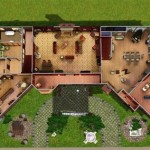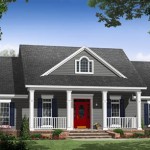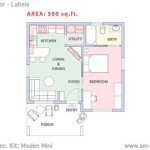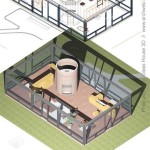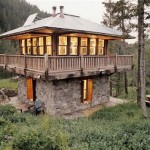In-Law Suite Home Plans
In-law suites, also known as accessory dwelling units (ADUs) or granny flats, are self-contained living spaces incorporated into a primary residence. They offer independent living quarters for extended family members while maintaining proximity to the main household. This arrangement provides numerous benefits for both the homeowner and the in-laws, fostering closer family ties while respecting individual privacy and independence. Choosing the right in-law suite home plan requires careful consideration of various factors, including family needs, budget, local regulations, and future adaptability.
Key Considerations for Choosing an In-Law Suite Home Plan
Selecting an appropriate in-law suite floor plan necessitates addressing several key considerations. These factors contribute to the functionality, comfort, and overall success of the integrated living arrangement.
- Size and Layout: Determine the necessary square footage based on the occupant's needs and lifestyle. Consider factors like bedroom and bathroom requirements, mobility accessibility, and desired living space.
- Privacy: Ensure adequate privacy for both the main house and the in-law suite. Separate entrances, soundproofing, and strategically placed windows can contribute to a comfortable and respectful living environment.
- Accessibility: Incorporate features that promote accessibility, especially if the occupants have mobility limitations. Consider wider doorways, ramps, grab bars, and zero-step showers.
- Connection to Main House: Decide on the degree of connection desired between the in-law suite and the main house. Options range from completely separate entrances to connected doorways for easy access.
- Budget: Establish a realistic budget for the construction or renovation project. Factor in material costs, labor expenses, and potential permit fees.
Types of In-Law Suite Home Plans
Various in-law suite designs cater to different needs and preferences. Understanding these options helps homeowners select the most suitable configuration for their property and family dynamics.
- Attached In-Law Suites: These suites are integrated directly into the main house, often sharing a wall or roof. They are a cost-effective option and provide easy access between the two living spaces.
- Detached In-Law Suites: Also known as granny flats or backyard cottages, these stand-alone structures offer maximum privacy and independence. They are ideal for larger properties and offer a greater sense of separation.
- Garage Conversion In-Law Suites: Existing garages can be converted into functional living spaces, providing a cost-effective solution for adding an in-law suite. This option often requires careful planning to ensure adequate living space and compliance with building codes.
- Basement In-Law Suites: Utilizing basement space for an in-law suite is another cost-effective option. However, it is crucial to address potential issues like dampness, lighting, and egress regulations.
Design Features for In-Law Suites
Specific design elements contribute to the comfort, functionality, and overall livability of in-law suites. Incorporating these features enhances the quality of life for the occupants.
- Kitchenette or Full Kitchen: Depending on the occupant's needs and preferences, a small kitchenette or a full kitchen can be incorporated. This provides independence for meal preparation and reduces reliance on the main house.
- Private Bathroom: A dedicated bathroom within the in-law suite ensures privacy and convenience. Consider incorporating accessibility features if needed.
- Living Area: A comfortable living area provides space for relaxation and socializing. Ensure adequate lighting and ventilation in this space.
- Storage Space: Incorporate ample storage space for clothing, personal belongings, and other necessities.
- Separate HVAC System: Providing a separate heating and cooling system allows for individual temperature control and optimizes energy efficiency.
Legal and Regulatory Considerations
Before embarking on an in-law suite project, it is essential to research and comply with local zoning ordinances and building codes. These regulations vary significantly by location and impact the feasibility and design of the suite.
- Zoning Regulations: Check local zoning laws to determine whether ADUs are permitted in your area and any restrictions on size, height, and placement.
- Building Permits: Obtain the necessary building permits before commencing construction or renovation. This ensures compliance with safety standards and avoids potential legal issues.
- Parking Requirements: Some jurisdictions require dedicated parking spaces for ADUs. Consider the parking situation on your property and incorporate appropriate solutions.
- Homeowners Association (HOA) Rules: If your property is subject to HOA regulations, verify any restrictions or requirements related to ADUs.
Financial Aspects of In-Law Suites
Building or renovating an in-law suite involves financial investment. Understanding the potential costs and financing options helps homeowners make informed decisions.
- Construction Costs: The cost of building an in-law suite varies depending on the size, design, and finishes. Obtain multiple quotes from contractors to compare prices and ensure competitive bidding.
- Financing Options: Explore various financing options, such as home equity loans, personal loans, or construction loans, to fund the project.
- Potential Return on Investment: While primarily intended for family use, an in-law suite can potentially increase the resale value of the property.
Long-Term Planning and Adaptability
Consider the long-term implications and potential future uses of the in-law suite. Designing for adaptability ensures the space remains functional and valuable over time.
- Future Use: Consider how the space can be utilized if it no longer serves as an in-law suite. It could be converted into a home office, guest suite, or rental unit.
- Flexibility in Design: Incorporate design features that allow for easy modifications or repurposing in the future.
- Resale Value: Consider the impact of the in-law suite on the overall property value and its appeal to potential buyers.
Careful planning and thoughtful consideration of these factors contribute to a successful and mutually beneficial in-law suite arrangement, enhancing family connections while respecting individual needs and privacy.

In Law Suite Plans Give Mom Space And Keep Yours The House Designers

Homes With Mother In Law Suites

Plan 65862 Tuscan Style House Floor Plans With 2091 Sq Ft 3 Be

Adding An In Law Suite Designing Your Perfect House

Pin By Jessie Brooks On Mother In Law Head Quarters 2024 Apartment House Floor Plans

6 Bedroom Country Style Home With In Law Suite The Plan Collection

Cape Cod House Plans With Inlaw Suite Best Of Mother In New Multigenerational Country

Exquisite Mountain Modern Home Plan With In Law Suite And 4 Car Garage 95104rw Architectural Designs House Plans

Front Side View House Plans With A Separate In Law Suite

House Plans With Mother In Law Suite

